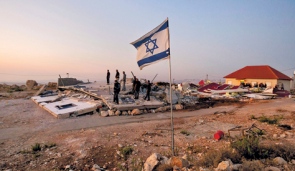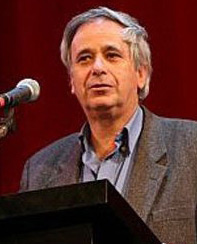EDITOR: The dispossession continues apace
While the mad group of people who populate this outpost is not itself important, the principle they represent is iconic and symbolic of the whole colonial project of Zionism, and the fact that it will never stop until it ‘liberates’ every square inch of Palestine, and rids the country of its inhabitants. There is no post-Zionism, just a continuation and furthering of the Nakba.
English billionaire linked to Israeli settlers’ attempts to prove ownership over Migron outpost: Haaretz
Foreign residents are forbidden from buying lands in the West Bank, though English billionaire Cyril Stein has been linked to land purchases in Migron.
By Chaim Levinson
In response to a 2006 Peace Now petition to evacuate the Migron outpost in the West Bank, the High Court of Justice ruled in 2007 that the land on which the Migron people were living was privately owned by Palestinians and the outpost had to be evacuated within a few months. It can be exclusively revealed here that the Migron settlers consequently organized a deal to buy land there with the help of English billionaire Cyril Stein.

Stein, who died in February 2011, was a North London Jew who made his fortune from gambling (turning Ladbrokes into a multibillion business ). He funded the $100 million Mamilla complex in Jerusalem, and donated a lot of money to settlements in East Jerusalem and the West Bank. In 2007, a Palestinian intermediary offered a deal to the Migron settlers: they could buy 25 dunams of land at the site for $75,000. The documents show the sides met in September 2007 at Stein’s apartment in Mamilla. Stein signed a contract with the fixer and immediately transferred the land to the Migron cooperative organization.
Foreign residents are forbidden from buying lands in the West Bank, and the Migron settlers say they bought it. Of course, they have been claiming throughout that there are no Palestinian owners of the land. Public Diplomacy Minister Yuli Edelstein also discussed Migron this week: “There are no owners here,” he said. “Okay, if some poor fellow with a family, children and grandchildren had come along and said I have nothing to eat, help me, but here there are no owners. There is a provocation here by some anti-Zionist organizations. I would be glad to acknowledge the owners if they existed.”
Nevertheless, the Migron settlers did take a number of other measures to purchase the land, the deal in which Stein was involved not being the only one. Recently, they filed a request at the Jerusalem District Court to register extensive areas of the outpost in their name, providing the court with a great many documents from 2003.
The issue of land deals in the West Bank is a knotty one. The root of the problem lies with the real danger to the life of anyone who tries to sell land to Jews. This began as a practice in the 1970s, and was anchored in law upon the establishment of the Palestinian Authority in 1994. A death sentence, which has yet to be carried out, was passed most recently in 2009, on a Palestinian from Hebron who sold lands.
In order to circumvent this problem, front men are used. These buy the land from its owners, then immediately transfer it to settlers and disappear from view. In many deals it has emerged that the front man cheated the landowners, or the land purchasers, and absconded with the money.
A problem that has arisen in recent years is the deaths of owners of lands that – in some areas – had been registered in the Jordanian land registry before the 1967 war. When a landowner dies, each of his heirs must obtain probate certification from the Sharia court in Ramallah, a process that has led to many attempts at falsification. Every land deal in the West Bank requires authorization in advance from the Civil Administration, but no one enforces this law in practice.
A brief history
The Migron settlers moved onto the hilltop land overlooking Highway 60 in 2001. In 2003, the state tried to stop the establishment of the outpost. Leaks from the Civil Administration informed the settlers of the legal opinions circulating within the administration, to the effect that Migron must be demolished because of its construction on private land. To preempt this, in May 2003 “purchase documents” for some of the land were submitted to the Civil Administration, which refused the registration request because of problems with the documents that aroused suspicion.
The police interrogated leading figures from the settlements under caution, but the investigation was closed two years ago because it was not possible to prove that the users of the documents had known they were forgeries. According to information from the investigation that has come into the possession of Haaretz, the Identification and Forensic Science police division found that the intermediary had forged some of the documents.
One of the owners of the land, who purportedly sold the lands by means of a notary in California, had died in 1961. The settlers claimed in response that a person with the identical name had died in 1961 and their seller was alive and existed, but that the notarized document had been forged. The national fraud squad conducted a judicial inquiry in California. The notary who purportedly had carried out the sale denied it and said his signature on the document was forged. Even though it was determined that the documents were forgeries, the inhabitants of Migron submitted them to the court last November, with the request to register the lands in their name.
One can learn something about the complex issue of West Bank lands from another prominent case now pending at the Jerusalem District Court: the matter of the “Brown House” – also known as Peace House or “Beit Hameriva” (“The House of Contention” ) – in Hebron. In 2007, settlers entered the large building, near the road leading from Kiryat Arba to the Cave of the Patriarchs, claiming they had bought it. However, the owner of the land claimed that had never happened. Then Defense Minister Amir Peretz ordered the evacuation of the building by force. The settlers submitted a request to the court in Jerusalem to have the land registered in their name.
Assaf Nehmad, who defined himself as someone active in “land acquisitions” for 17 years (and is also involved in the current case concerning ownership of another Hebron residence, Machpela House ), testified to the court in Jerusalem: “Three or four months before March 2004, I was contacted by a person who was a former resident of Hebron and now lives in Jerusalem. This is a person who locates real estate assets. He contacted me and said it was about a property I might be interested in, saying, ‘The owners are looking to sell, but they have a condition, that there be no connection to Jews.’ I asked him where the property was. He told me it was in the area the army calls ‘the Zion axis’ [the main road in the part of Hebron under Israeli control]. The moment we realized this was the place, it was clear that it was a property they had been trying to sell for a long time and had not been sold to an Arab. That person connected me with some people I know. In the nature of things, we looked for the right person to turn to in a way that they’d understand they wouldn’t be exposed. The person who had contacted me could not be a go-between. That person’s role was to identify and sell a deal, like a broker. Here, because of their requirement, there had to be an Arab person who buys it so they could meet among themselves with an Arab person.
“To our delight, he had a previous connection with a person named Ayoub Jabbar. The story fit like a glove. I asked him if he were interested in being a part. He made contact with them and understood from them what the conditions were. We paid something like 2 to 2.5 times more than the real price, but it was clear they were looking for a high price. The whole world knows he talks to the Jews. They wanted to sell it to Jews because we pay a lot more. The property had been abandoned for eight years; there had been an attempt to rent it that didn’t work out. We were the best offer.
“I know all this information from that same person and also from my familiarity with the territory. I was not in contact with the owner. This was an acquisition procedure that is contradictory and alien both to the cultural practices in Hebron and to the procedure dictated to them by the Palestinian Authority. Because they very much wanted to sell they accepted all the conditions … I did not meet the owners. The only one who met them was Ayoub. This is a practice of acquisitions. It is important to stress that this is very different from the way acquisitions are done among Arabs. Even significantly.”
Nehmad acknowledged that the Civil Administration had refused their request to receive a permit for the deal. The decision on this case is slated to be handed down this year. Settlers in Migron refused to respond to this story.
Rashid Khalidi: David Ben-Gurion and Israel’s Expulsion of the Palestinians: IOA
5 APRIL 2012
The Journal of Palestine Studies / Palestine Studies TV
Ben-Gurion and the Transfer of Arabs
On 3 November 2011, the self-appointed media watchdog CAMERA (Committee for Accuracy in Middle East Reporting in America) informed the Journal of Palestine Studies of an incorrect citation in an article by Ilan Pappé (“The 1948 Ethnic Cleansing of Palestine”) published in its autumn 2006 issue. The incorrect citation referred to a quotation by Israeli founding father David Ben-Gurion supporting the expulsion (“transfer”) of Arabs from Palestine.
CAMERA asked JPS to “issue a correction stating that the quote attributed to Ben-Gurion does not appear in the references cited” in JPS and its website “to prevent further erroneous uses of this quote.”

CAMERA’s accusations (e.g., 3 February 2012) that Pappé “invented” or “fabricated” the quotation, suggesting that the Zionist leader had never supported transfer, led JPS to have the original source — Ben-Gurion’s 5 October 1937 letter to his son — translated into English. The letter vindicates Pappé’s reading of Ben-Gurion’s position on transfer and the essential accuracy of his article. While JPS regrets the lapses of citation, the 2006 article, fully consonant with the historical record, remains in our view an excellent summation of Zionist planning behind the Palestinian expulsions of 1948.
In the links below, readers will find JPS’s official response to CAMERA (published in the winter 2012 issue), the full English translation of Ben-Gurion’s letter (to our knowledge never published before), the original Hebrew (from the Ben-Gurion Archives), and a link to Pappé’s article. Because CAMERA has cited Benny Morris in support of its position (also in an article by a CAMERA official 12 November 2011), we are posting a long 2004 interview with Morris which unequivocally elaborates on Ben-Gurion’s “transferist” aims. Be sure to check back, as we will be publishing other materials related to the controversy in the coming weeks.
RELATED
JPS Response to CAMERA, Winter 2012
Ilan Pappé’s 2006 article in JPS
English translation of the David Ben Gurion 1937 letter
Original David Ben Gurion letter (Hebrew)
Benny Morris 2004 interview on the 1948 expulsion